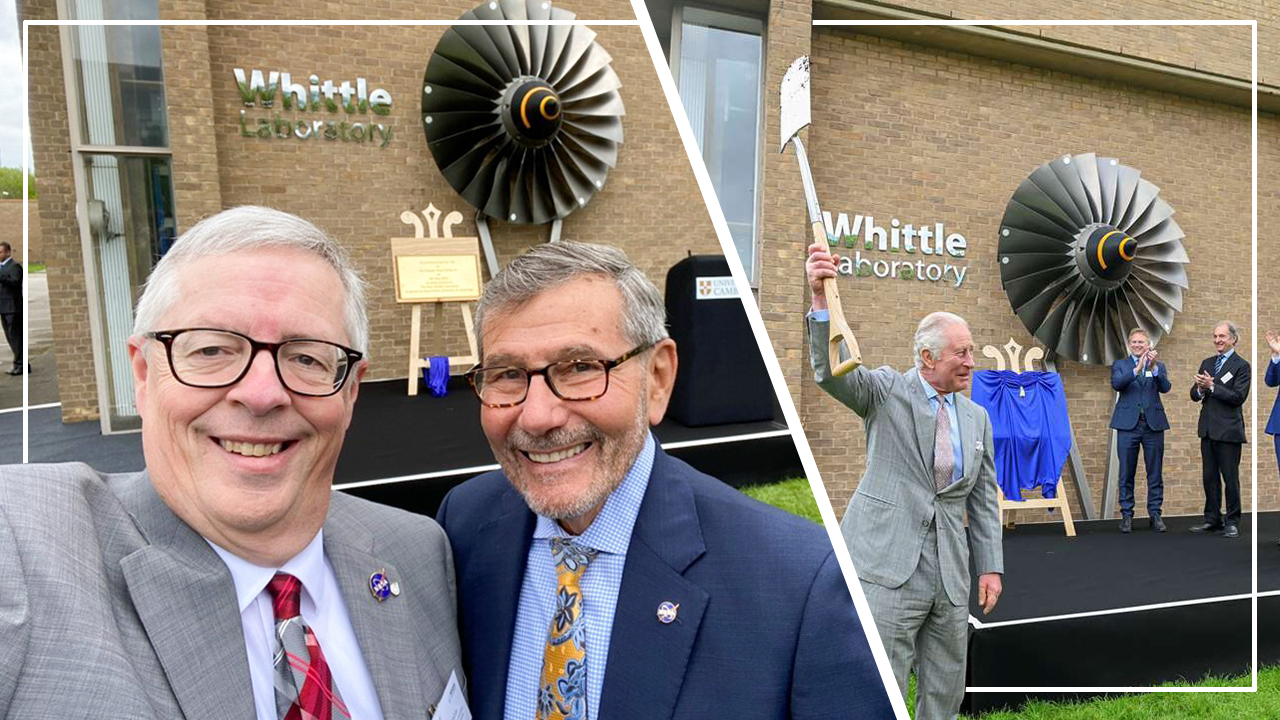King Charles consults Auburn aerospace grad on sustainable aviation, neckties
Published: Jun 1, 2023 7:00 AM
By Jeremy Henderson
Ed Waggoner, '69 aerospace engineering, is the deputy associate administrator for programs for NASA's Aeronautics Research Mission Directorate — ARMD they call it. He lives in Alexandria, Virginia, just across the river from D.C. But one of his favorite men's stores is the Locker Room in Auburn. He'll get back to town usually once a year or so, visit his sister Cindy in Grove Hill, walk around the ol' alma mater, reminisce about studying aerodynamics and fluid dynamics in the days leading up to the Giant Leap. And he'll stop by the Locker Room. He's big on ties; the Locker Room has some good ones.
The one he wore that time he testified before congress on unmanned aircraft? That might have been from the Locker Room. Ditto the one he wore that other time he testified before congress on unmanned aircraft.
But, though he knows it'd make for a better story, he has to be honest — he's pretty sure the nice little blue and yellow number he packed for his recent trip to Cambridge is from Nordstrom. At the moment, it's probably his fanciest. And as the trip got closer, there was something about the way the Cambridge folks started talking that made him think the fancier the better.
He'd been invited to a roundtable discussion held in conjunction with the Thursday, May 9 groundbreaking on the university's new £58 million addition to their famed turbomachinery-focused Whittle Laboratory, which is set to be the UK’s first Disruptive Innovation Laboratory for sustainable aviation and energy.
He knew there would be plenty of government and industry bigwigs attending — high level policy makers and academics and such from across Europe. But the week before he left to represent America's space administration at the proceedings, the tone changed a little. There wouldn't just be VIPs in attendance, Waggoner was told — there'd be a VVIP: a very, very important person.
Honestly, they probably could have thrown another V on there.
"The weekend before the event, they told us the Palace was allowing them to say it was King Charles," Waggoner said. "I really didn't think that King Charles was going to be there. I thought something would probably come up."
... something, like, say, the first royal coronation in 70 years, happening that day. But then, that Monday, the organizer, Whittle Lab director Rob Miller, reached out again.
Dear Edgar,
I just wanted to alert you to the fact that His Majesty was hoping to have a brief word with you at the end of the roundtable discussion... It will only be a few minutes conversation, but I know he is keen to say how pleased he is that you have been able to join us.
Waggoner crossed the pond, unpacked, and tied the best half Windsor knot of his life.
When it was time, he made his way to Whittle. The roundtable went well. He listened to reps from the UK government, the UK Aerospace Technology Institute, the Federal Aviation Administration, EU Clean Aviation Joint Undertaking, Airbus, Boeing, Rolls-Royce and the Sustainable Markets Initiative lay out their tactics for achieving net-zero carbon emissions for aviation by 2050, which Waggoner calls a "real pillar of NASA's aeronautics portfolio." He detailed NASA's own work on new propulsion systems aimed at the same goal. Then he did the same for the House of Windsor in what was the King of England's first public engagement following his coronation.
"The King showed up right on time," Waggoner said. "He spent 45 minutes with us, asking questions about what the roundtable was addressing, and then at the end of that, that's when I actually met with him."
Waggoner was one of six His Majesty wanted a one-on-one with, one of only three eventually referenced in the Crown's official court circular after the event. He was positioned second to last. Palace officials asked photographers to leave the room. The King got closer.
"I saw that he was wearing the same ring he was wearing on the cover of TIME Magazine," Waggoner said. "I was wearing my Auburn ring. We shook hands and spoke briefly. He was charming, funny, articulate. He was genuinely interested in what we were doing."
While attending Cambridge in the late 1960s, the then Prince of Wales actually earned a pilot's license under the Royal Air Force while studying aerodynamics and aviation.
"He's really an aviation enthusiast, and an enthusiast for reducing climate change," Waggoner said.
And, apparently, a fashion enthusiast, too.
"When we finished talking, he went on to the next person, but then turned and came back," Waggoner said. "He said 'oh, I would be very interested in partnering with NASA in some of our space exploration as well.' I told him I'd take that message back with me.
"Then he said, 'oh, and splendid tie.'"
Media Contact: , jdh0123@auburn.edu, 334-844-3591
1969 aerospace engineering graduate Ed Waggoner (middle, splendid tie) poses at the May 9 groundbreaking on the new £58 million addition to the University of Cambridge's famed Whittle Laboratory. Waggoner, deputy associate administrator for programs for NASA's Aeronautics Research Mission Directorate, participated in a roundtable discussion on sustainable aviation before the event, which was the first public engagement for King Charles following his May 6 coronation. The King spoke one-on-one with Waggoner about NASA's work on disruptive innovation in net zero aviation and energy.

